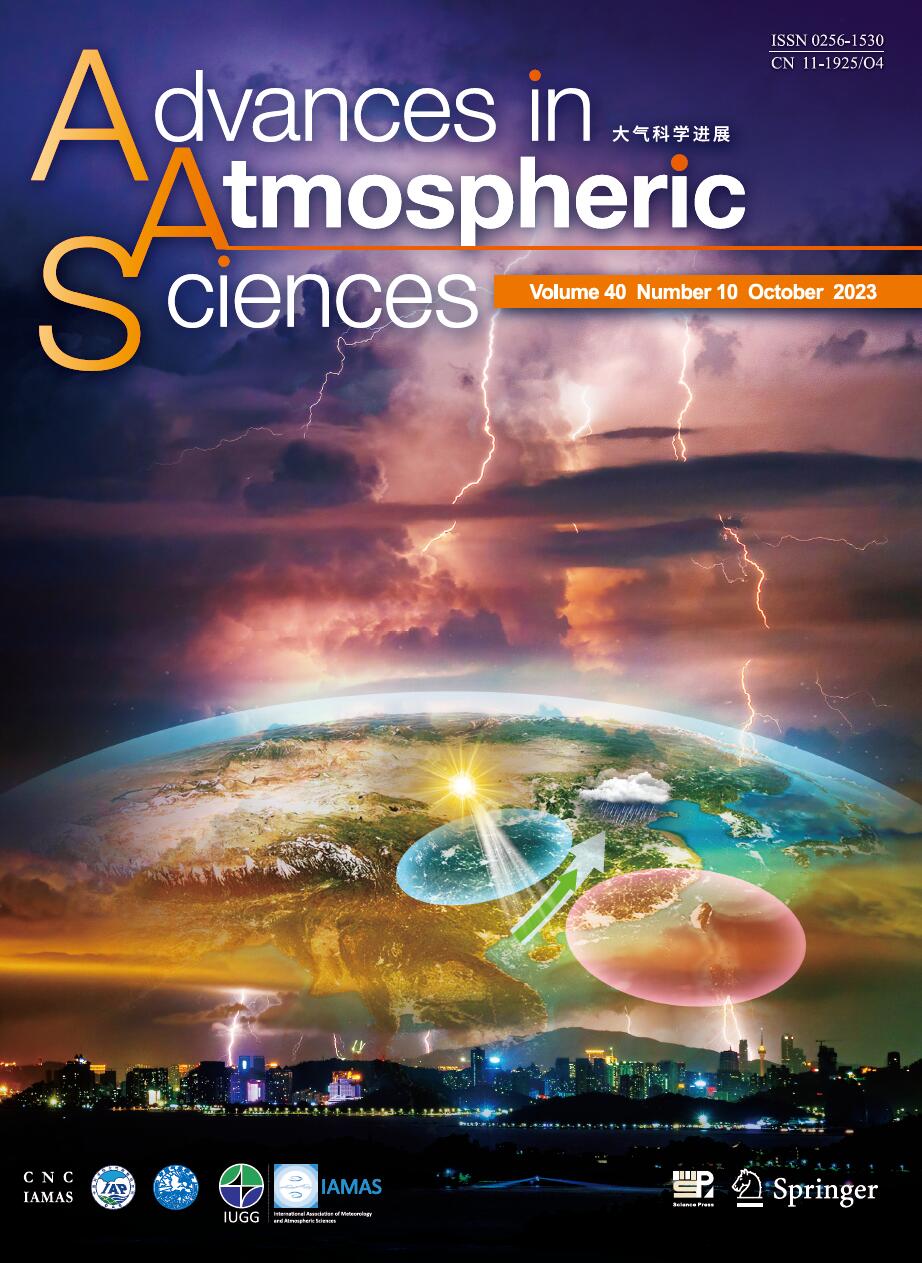| [1] |
Yong-Sang CHOI, Chang-Hoi HO, Sang-Woo KIM, Richard S. LINDZEN,
2010: Observational Diagnosis of Cloud Phase in the Winter Antarctic Atmosphere for Parameterizations in Climate Models, ADVANCES IN ATMOSPHERIC SCIENCES, 27, 1233-1245.
doi: 10.1007/s00376-010-9175-3
|
| [2] |
WU Tongwen, LIU Ping, WANG Zaizhi, LIU Yimin, YU Rucong, WU Guoxiong,
2003: The Performance of Atmospheric Component Model R42L9 of GOALS/LASG, ADVANCES IN ATMOSPHERIC SCIENCES, 20, 726-742.
doi: 10.1007/BF02915398
|
| [3] |
WANG Zaizhi, WU Guoxiong, WU Tongwen, YU Rucong,
2004: Simulation of Asian Monsoon Seasonal Variations with Climate Model R42L9/LASG, ADVANCES IN ATMOSPHERIC SCIENCES, 21, 879-889.
doi: 10.1007/BF02915590
|
| [4] |
Jun ZHANG, Jiming SUN, Wei DENG, Wenhao HU, Yongqing WANG,
2023: The Importance of the Shape Parameter in a Bulk Parameterization Scheme to the Evolution of the Cloud Droplet Spectrum during Condensation, ADVANCES IN ATMOSPHERIC SCIENCES, 40, 155-167.
doi: 10.1007/s00376-022-2065-7
|
| [5] |
Xi WANG, Zheng GUO, Yipeng HUANG, Hongjie FAN, Wanbiao LI,
2017: A Cloud Detection Scheme for the Chinese Carbon Dioxide Observation Satellite (TANSAT), ADVANCES IN ATMOSPHERIC SCIENCES, 34, 16-25.
doi: 10.1007/s00376-016-6033-y
|
| [6] |
Lei WANG, Qing BAO, Wei-Chyung WANG, Yimin LIU, Guo-Xiong WU, Linjiong ZHOU, Jiandong LI, Hua GONG, Guokui NIAN, Jinxiao LI, Xiaocong WANG, Bian HE,
2019: LASG Global AGCM with a Two-moment Cloud Microphysics Scheme: Energy Balance and Cloud Radiative Forcing Characteristics, ADVANCES IN ATMOSPHERIC SCIENCES, , 697-710.
doi: 10.1007/s00376-019-8196-9
|
| [7] |
SHOU Yixuan, LI Shenshen, SHOU Shaowen, ZHAO Zhongming,
2006: Application of a Cloud-Texture Analysis Scheme to the Cloud Cluster Structure Recognition and Rainfall Estimation in a Mesoscale Rainstorm Process, ADVANCES IN ATMOSPHERIC SCIENCES, 23, 767-774.
doi: 10.1007/s00376-006-0767-x
|
| [8] |
Yangang LIU, Man-Kong YAU, Shin-ichiro SHIMA, Chunsong LU, Sisi CHEN,
2023: Parameterization and Explicit Modeling of Cloud Microphysics: Approaches, Challenges, and Future Directions, ADVANCES IN ATMOSPHERIC SCIENCES, 40, 747-790.
doi: 10.1007/s00376-022-2077-3
|
| [9] |
Xiaofei LI, Qinghong ZHANG, Huiwen XUE,
2017: The Role of Initial Cloud Condensation Nuclei Concentration in Hail Using the WRF NSSL 2-moment Microphysics Scheme, ADVANCES IN ATMOSPHERIC SCIENCES, 34, 1106-1120.
doi: 10.1007/s00376-017-6237-9
|
| [10] |
Yaodeng CHEN, Ruizhi ZHANG, Deming MENG, Jinzhong MIN, Lina ZHANG,
2016: Variational Assimilation of Satellite Cloud Water/Ice Path and Microphysics Scheme Sensitivity to the Assimilation of a Rainfall Case, ADVANCES IN ATMOSPHERIC SCIENCES, 33, 1158-1170.
doi: 10.1007/s00376-016-6004-3
|
| [11] |
DAI Fushan, YU Rucong, ZHANG Xuehong, YU Yongqiang, LI Jianglong,
2005: Impacts of an Improved Low-Level Cloud Scheme on the Eastern Pacific ITCZ-Cold Tongue Complex, ADVANCES IN ATMOSPHERIC SCIENCES, 22, 559-574.
doi: 10.1007/BF02918488
|
| [12] |
Feifei SHEN, Aiqing SHU, Zhiquan LIU, Hong LI, Lipeng JIANG, Tao ZHANG, Dongmei XU,
2024: Assimilating FY-4A AGRI Radiances with a Channel-Sensitive Cloud Detection Scheme for the Analysis and Forecasting of Multiple Typhoons, ADVANCES IN ATMOSPHERIC SCIENCES, 41, 937-958.
doi: 10.1007/s00376-023-3072-z
|
| [13] |
Chen ZHOU, Yincheng LIU, Quan WANG,
2022: Calculating the Climatology and Anomalies of Surface Cloud Radiative Effect Using Cloud Property Histograms and Cloud Radiative Kernels, ADVANCES IN ATMOSPHERIC SCIENCES, 39, 2124-2136.
doi: 10.1007/s00376-021-1166-z
|
| [14] |
Jinghua CHEN, Xiaoqing WU, Chunsong LU, Yan YIN,
2022: Seasonal and Diurnal Variations of Cloud Systems over the Eastern Tibetan Plateau and East China: A Cloud-resolving Model Study, ADVANCES IN ATMOSPHERIC SCIENCES, 39, 1034-1049.
doi: 10.1007/s00376-021-0391-9
|
| [15] |
Rajabu J. MANGARA, Zhenhai GUO, Shuanglin LI,
2019: Performance of the Wind Farm Parameterization Scheme Coupled with the Weather Research and Forecasting Model under Multiple Resolution Regimes for Simulating an Onshore Wind Farm, ADVANCES IN ATMOSPHERIC SCIENCES, 36, 119-132.
doi: 10.1007/s00376-018-8028-3
|
| [16] |
Xiaoqing WU, Xiaofan LI,
2008: A Review of Cloud-Resolving Model Studies of Convective Processes, ADVANCES IN ATMOSPHERIC SCIENCES, 25, 202-212.
doi: 10.1007/s00376-008-0202-6
|
| [17] |
GAO Shouting, Xiaofan LI,
2008: Impacts of Initial Conditions on Cloud-Resolving Model Simulations, ADVANCES IN ATMOSPHERIC SCIENCES, 25, 737-747.
doi: 10.1007/s00376-008-0737-6
|
| [18] |
Liu Hui, Zhang Xuehong, Wu Guoxiong,
1998: Cloud Feedback on SST Variability in the Western Equatorial Pacific in GOALS / LASG Model, ADVANCES IN ATMOSPHERIC SCIENCES, 15, 412-423.
doi: 10.1007/s00376-998-0011-y
|
| [19] |
Sun Shufen, Li Jingyang,
2001: A Sensitivity Study on Parameterization Scheme of Snow Internal and Interfacial Processes in Snow Model, ADVANCES IN ATMOSPHERIC SCIENCES, 18, 910-928.
|
| [20] |
Zhang Yu, Lu Shihua,
2002: Development and Validation of a Simple Frozen Soil Parameterization Scheme Used for Climate Model, ADVANCES IN ATMOSPHERIC SCIENCES, 19, 513-527.
doi: 10.1007/s00376-002-0083-z
|















 AAS Website
AAS Website 
 AAS WeChat
AAS WeChat 
 DownLoad:
DownLoad: